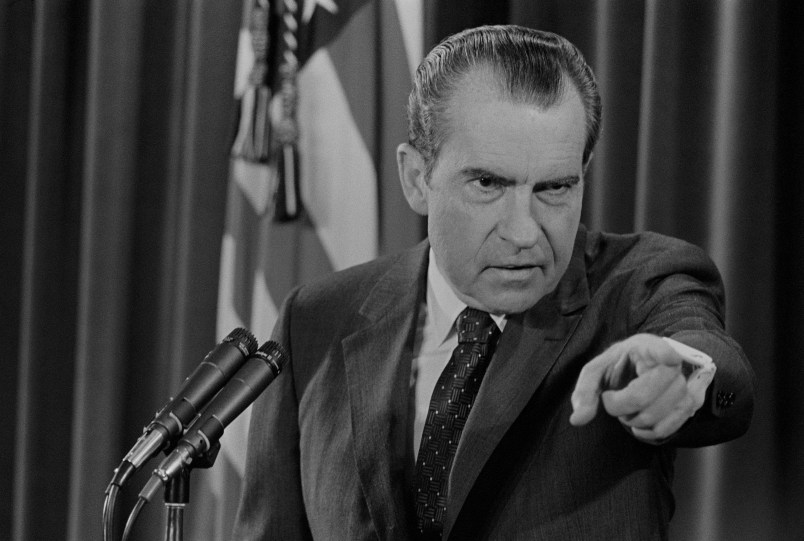When most people think of the great civil right achievements of the 1960s, two famous laws come to mind: the Civil Rights Act of 1964 and the Voting Rights Act of 1965. But there was a third great civil rights law that is far too often forgotten—and could not be more relevant to today’s presidential debate.
The Immigration and Nationality Act of 1965 just turned 50 on October 3. The law brought a sweeping overhaul to the U.S. immigration system, and changed the racial and ethnic complexion of America.
The core principles of the Immigration Act of 1965 were consistent with the other two civil rights laws—racial justice and equal treatment under the law. The 1965 Act was a watershed moment because, for the first time in U.S. history, the nation abandoned a national origins-based system of immigration. From its creation, that system had privileged immigrants based on racist perceptions of the superiority of Western Europeans over those from the developing world.
Instead, the 1965 Act instituted a national origins-neutral selection system by which each nation in the Eastern hemisphere was given a 20,000 per country limit. The logic shifted from picking people based on their race or national origin to admitting them based on a race and nationality neutral system that emphasized the new dual priorities of family reunification and U.S. labor market needs. In addition, Western hemisphere nations were subject to an overall numerical cap for the first time and were moved to the same 20,000 per country limit by 1977.
The framers of the Act, including LBJ himself, did not anticipate that it would literally change the makeup of the nation, but it did—dramatically.
Here’s what that change looked like: In the 1950s and early ‘60s, more than 50 percent of all legal immigrants to the U.S. were white ethnic Europeans. Only 6 percent of legal immigrants came from Asia and another 6 percent came from Mexico. After the passage of the 1965 Act, half the legal immigrants are from Latin America, and one quarter are from Asia.
The 1965 Act marked a huge step towards a more just nation, but, like the Civil Rights and Voting Rights Act, it was far from perfect. In particular, the annual 20,000 immigrants per country limit led to significant flows of undocumented immigrants, many from Mexico and Central America.
When the demand for legal visas exceeded the supply, migrants entered surreptitiously or overstayed their temporary visas. In 1986, to address the issue, President Ronald Reagan signed the Illegal Immigration Reform and Control Act.
Reagan’s law aimed to close the back door to undocumented immigration and to bring into the sunlight the undocumented population that was already in the U.S. It accomplished these two goals by implementing for the first time an employer sanctions system that penalized U.S. employers who were also breaking immigration law, and instituting the I-9 system, which was supposed to ascertain which workers are legally authorized to work in the U.S.
At the same time, in recognition of the fact that an undocumented population living in the shadows was open to exploitation and abuse, the law gave 2.7 million people legal status, providing them with amnesty and a path to citizenship.
The Illegal Immigration Reform and Control Act was hailed as tough, visionary, and compassionate. Its legacy is more mixed. The employer sanction provisions proved ineffective in curbing undocumented immigration given the proliferation of fraudulent documents and under-enforcement of immigration laws in the interior of the U.S.
Nevertheless, like in the 1965 Act, the 1986 law offered a multi-pronged approach that matched the multifaceted nature of the immigration phenomenon. It sought to humanely treat the undocumented population who resided in the U.S., while simultaneously reducing employers’ incentives to hire undocumented workers. It did so with the politically pragmatic approach of combining enforcement and benefits components into the same bill, thereby goring immigration advocates’, unions’, and business’ sacred oxen and ensuring passage through a coalition of strange bedfellows.
Donald Trump and much of the GOP primary field’s immigration reform proposals are unconstructive reactions, not improvements, to the 1965 Act—and they mark a repudiation of Reagan’s balanced approach. Building a wall, repealing birthright citizenship, mass deportation, tracking immigrants like Fedex packages, and admonishing immigrants to learn English are not policy solutions. They are reactions to the cultural and demographic changes that immigration has brought to the U.S.
Let’s be clear: despite the homage GOP candidates constantly pay to their beloved Regan, none of them—with the possible exception of Jeb Bush and Marco Rubio, both of whom have previously supported comprehensive reform with a path to citizenship—has proposed anything approaching the seriousness of Reagan’s reform reform. So instead of real solutions to a complex problem, what we have on the table are a series of piecemeal reforms designed to appeal to the party base but that are not really politically or practically viable. It is true that neither the 1965 law nor the 1986 law permanently solved the nation’s immigration ills. But at least they were sober and even bold attempts to address the nettlesome subject.
Anna O. Law holds the Herbert Kurz Chair in Constitutional Rights at the City University of New York, Brooklyn College. She is a member of the Scholars Strategy Network.










tRump did not get this wrong. It was a stupid law enacted by a bunch of losers. His reforms will be yuuuuuuuuuuuugely successful, classy. You’ll see.
Reagan opened his 1980 presidential campaign (where he trounced Jimmy Carter) by going to Philadelphia MS to talk about states’ rights. Three civil rights workers were killed in that town in1964 by the KKK, and. That’s who he was.
Good deal for Brunei and Nauru, not so good for China and India…
When the pope visited, I didn’t see him being concerned with giving compassion to US Citizens who are poor, uneducated, who have lost their jobs to Illegal Aliens. This effect was warned about in 1965:
http://www.newswithviews.com/Spingola/deanna3.htm
“In light of our 5 percent unemployment rate, our worries over the so called population explosion, and our menacingly mounting welfare costs, are we prepared to embrace so great a horde of the world’s unfortunates? At the very least, the hidden mathematics of the bill should be made clear to the public so that they may tell their Congressmen how they feel about providing jobs, schools, homes, security against want, citizen education, and a brotherly welcome… for an indeterminately enormous number of aliens from underprivileged lands.” “We should remember that people accustomed to such marginal existence in their own land will tend to live fully here, to hoard our bounteous minimum wages and our humanitarian welfare handouts…lower our wage and living standards, disrupt our cultural patterns.” Myra C. Hacker, Vice President of the New Jersey Coalition of Patriotic Societies, on the 1965 Hart Celler Act
“Whatever may be our benevolent intent toward many people, the bill fails to give due consideration to the economic needs, the cultural traditions, and the public sentiment of the citizens of the United States.” Myra C. Hacker, on the 1965 Hart Celler Act
Also, isn’t it interesting that the catholic church is one of the largest recipient of financial “donations” in the world? If the pope is so concerned for these migrants, then why doesn’t he exhort those countries (including his native Argentina) to take care of their citizens in need?
Catholic Church collects $1.6 billion in U.S. contracts, grants since 2012
“Not to be lost in the pomp and circumstance of Pope Francis’ first visit to Washington is the reality that the Catholic Church he oversees has become one of the largest recipients of federal largesse in America.”
https://www.donaldjtrump.com/positions/immigration-reform
Trump outlines ways to fund his points: stop sending funds to Mexico, a tariff on trade, a tax on money transfers, etc. The USA can find ways to get this done. Not mentioned what Illegal Aliens cost us now and will cost us in the future:
What if 20 Million Illegal Aliens “Just Departed”
Um, A LOT would happen!